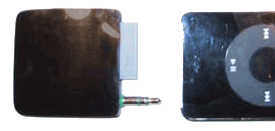
Update: The concept of using the controls of the media player across home and mobile solutions has gained momentum as wireless technology was merged with the media players. The concept was proven in the 2010 Apple promotion of AirPlay across the iPhone, iTouch, iPad and AppleTV.
original 2007 thoughts...
By 2005 it had become apparent that the first (RF) wireless remote controls for portable media players were little better than IR controls. What I'll call Phase I wireless replaced the good controls of the players with inferior controls, and removed the feedback of the screen. Players - especially after the iPod nano was released, are small enough to be the source and the remote.
Phase II - Wireless Player as Control and Source
By leaving the player in the user's hands, the superior User Interface (UI) of the player is retained. Removal from the base would impact battery life, and possibly fidelity.
Using the iPod as an example, three options were initially identified for transmitting the higher bandwidth audio (video) signals - the last two are used by companies to-date: 1) capture a digital stream from the player's base connector for direct RF transmission, and perform the analog conversion once at the base station. According to Apple this was not going to be available. Concerns of bypassing DRM could be an issue. 2) Use the analog signal of the headphones and re-digitize the signal for transmission. This is how FM transmitters work, and it enables volume control at the player, but at the price of fidelity (fidelity is already limited in FM transmission). 3) Use the analog signal at the base connector. This ensures better fidelity, but removes volume control at the player.
A fourth option was explored: Request the volume settings from the iPod base connector (iPod software update) and transmit it with the digitized analog signal. This would provide volume control at the media player and retain higher fidelity in the link. Apple indicated that the volume settings would not be available to Made for iPod vendors.

A fifth approach was particularly applicable to the nano: Digitize the base connector signal to maintain fidelity and sense the difference between the base connector signal level and the headphone signal level to obtain the volume setting.
This methods was less appealing when the 5G iPods were announced without the co-location of sources again.
One final approach was considered - replace the iPod OS with Linux (already in the public domain) and capture the digital streams and volume settings directly. This deviated too far from the core product.
By late 2005, several iPod accessories vendors began to announce similar devices. Prototypes were displayed at the 2006 Mac World. Evaluation to move forward included the following considerations:
1) Apple sets the quality of external wireless solutions by controlling the information available from the base connector. It is expected Apple will some day integrate wireless connectivity into their media players. They will be able to optimize fidelity by transmitting volume settings and by reducing the number of analog-digital conversions;
2) A broader-based product line was not developed to compete against current accessories vendors or reduce the impact should Apple announce a wireless solution;
The final products released by the 3rd party vendors are still missing several key features planned for the iPod version of unLeashed:

 |
They did not maintain the fidelity and volume control of unLeashed; |
 |
Their designs did not facilitate whole-home entertainment where players could be added and removed from home zones; |
 |
They have not yet indicated functionality across the different environments - home, car, travel speakers, wireless headphones. |
Phase III - Socializing the Player
Once increased wireless bandwidth is established for a base station, it is a small change in hardware, software, and user interface to implement sharing content between users - either temporarily or permanently. This is one of the defining features of the Zune player.
Phase IV - Media Player as Part of a Larger System
Future item, only available under the Login right now. Please check back soon.
| << Vision |